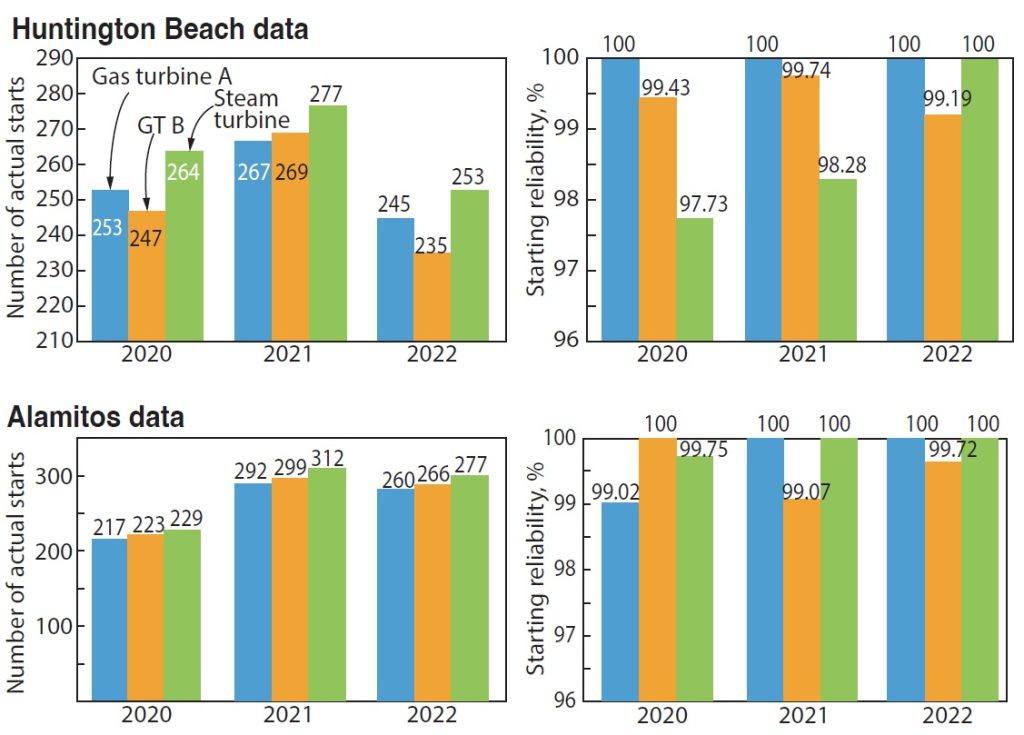
AES Huntington Beach Energy
AES Alamitos Energy
Owned by AES Southland
Operated by AES CorpEach plant, rated a nominal 674 MW, is a 2 × 1 combined cycle powered by GE 7F.05 gas turbines and Siemens SST6-5000 steam turbine, located in Huntington Beach, Calif
Plant manager: Weikko Wirta
Challenge. Achieve world-class starting reliability.
Solution. AES Huntington Beach Energy and AES Alamitos Energy implemented robust process optimization programs to achieve close to 100% starting reliability on its gas and steam turbines since COD in early 2020.
Startup failure (SF) means an outage that results when a unit is unable to synchronize within a specified startup time following an outage or reserve shutdown. NERC defines a startup period to begin with the command to start and end when the unit is synchronized. SF begins when a problem preventing the unit from synchronizing occurs; it ends when the unit is synchronized, another SF occurs, or the unit enters another permissible state.
Both plants have 20-yr power purchase agreements with two starts daily. To meet this requirement, plant personnel were proactively involved with project construction and commissioning activities, together with the EPC contractor’s commissioning team.
AES management and the EPC contractor provided all operations and maintenance personnel 10 weeks of plant-specific training. In addition to this in-person training, the team also received DCS simulator training.
At the end of commissioning, a couple of experienced contract operators were hired to fill open operator positions for a year. Contract operators and the AES operations team updated operating instructions, prepared startup checklists, reviewed and established alarm priorities on the DCS,
The team has been tracking plant operational challenges to achieve 100% startup reliability during the post-COD period. Startup-failure and plant-trip data have been well analyzed and internal RCA discussions have been carried out by the team for improving overall plant reliability.
To achieve 100% starting reliability, a pre-start checklist has been used on every startup/shutdown and signed off by a control room operator and plant equipment operator. Operators have been required to finish familiarization training, as well as to follow well-established plant startup and shutdown procedures.
In addition, plant O&M technicians have been coordinating to meet plant operational priorities and actively avoid equipment failures. Weekly planning and scheduling meetings have managed to effectively resolve plant discrepancies. Operators have been using the OEM’s digital asset performance monitoring system for tracking equipment performance.
Preventive operational checks have been carried out weekly, monthly, and quarterly to prevent plant discrepancies, while predictive and preventive maintenance have been done effectively.
Performance and predictive monitoring tools—such as EtaPRO, advanced pattern recognition, and Predictor vibration monitoring—are used. To immediately resolve plant issues, IC&E technicians have been assigned in swing shifts.
After every annual outage, an effective commissioning and testing procedure checklist is followed before a plant restart. Additionally, the OEM’s M&D support center has been helping and troubleshooting any unknown complications for the gas turbines.

Results. Even averaging more than 250 annual starts in the last three years of operations, plant starting reliability has been averaging 99% (bar charts). This enviable achievement is attributed to the implementation of the process optimizations programs described above.
Project participant:
Damodaran Sri Ramulu, operations manager









